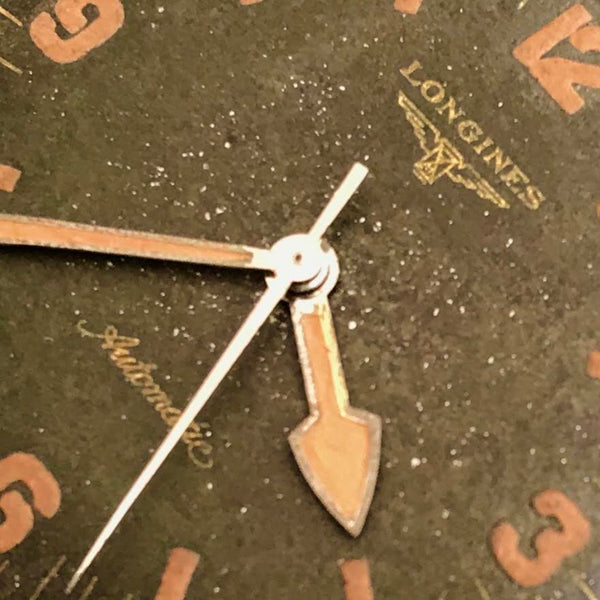The History of Longines’ Early Diving Watches
Everyone is probably familiar with the history of the "diver's watch."
As diving became popular among the masses in the 1950s, watch brands began making diver's watches for the masses.
Rolex, Blancpain and Doxa are the brand names most closely associated with diving watches in the mid-20th century, with many others following suit.
But what I particularly love about this era is the history of Longines.
Previously known for making some of the best in-house chronograph calibers ever made, Longines has a history of trying to branch out into the diving world, creating some very fine diver's watches in the process.
Rolex, Longines and the Trieste
In 1960, some people thought it would be interesting to use a U.S. Navy bathyscaphe to go off the coast of Guam to the deepest part of a hole in the middle of the Mariana Trench called the Challenger Deep.
The two men who carried out this project were Swiss scientist Jacques Piccard and U.S. Navy Captain Don Walsh.
"To be honest, it got a bit boring" once the nine-hour dive began, they later said of the deepest dive in human history.
Since timing is extremely important when diving, watches from three different companies were used to ensure the success of this dive.
Rolex, Movado, Longines.
Rolex, being the consummate marketer that they are, thought it would be funny to strap a "watch" to a bathyscaphe that could dive to a depth of 10,916 meters.
So I gave Piccard a watch called the Deep Sea Special and had him attach it to the outside of the submarine.
According to Rolex, after the dive, Picard sent the company a telegram stating, "I am pleased to report that my Rolex watch worked as well at a depth of 11,000 metres as it did on land."
In 2012, famous film director James Cameron undertook the same record-breaking dive as Picardo and Walsh, and once again Rolex was sure to celebrate the endeavor.
To be honest, I didn't know much about the Trieste's undersea expedition until I learned more about the history of Rolex dive watches.
For some reason, undersea exploration was often discussed with a PR spin from Rolex, touting their superior technology with phrases like "watches for undersea exploration."
This is a bit disappointing.
Its use in publicity has obscured what an incredible feat of humankind under the sea exploration is.
Again, this is the deepest dive in human history, an extremely deep dive, reaching the deepest depths of the Earth.
The fact that the watch brand strapped a little something to the outside of the submarine is just a minor addition to this feat of undersea exploration.
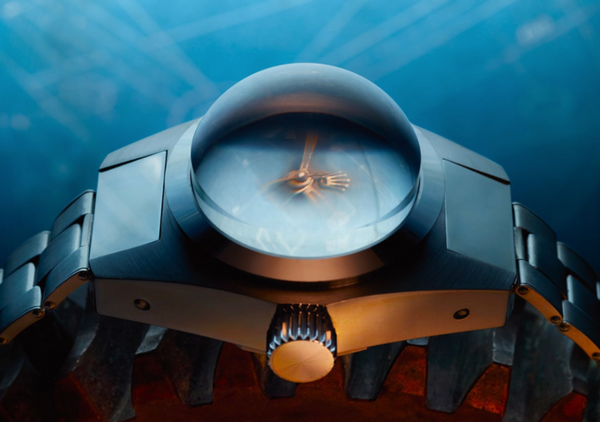
(A Rolex Deep Sea Special that was attached to the Bathyscaphe Trieste and dived to a depth of 10,916 meters)
Longines: Deep Sea Diving
At the time of the Trieste dive, Longines was already producing diver's watches, but at that time Longines was still best known for its extensive chronograph manufacturing capabilities.
For this reason, two Longines stopwatches were used on board the submarine to measure the operating times of the ballast tanks.
With brands like Rolex, Blancpain and Breitling branching out into undersea applications, the opportunity to serve divers, even if only inside a submarine, wasn't such a bad idea for Longines.

(Longines stopwatches were used on the Bathyscaphe Trieste)
Longines certainly had its share in this great achievement in horology, but it was never in a position to claim it as the master of it all.
In the late 1950s, Longines had already launched the Nautilus Skin Diver and Compressor.
However, by that time brands such as Rolex and Omega had already captured consumer interest, so the Longines Nautilus Skin Diver and Compressor did not enjoy immediate market success.
The involvement of Longines watches in the Trieste underwater expedition gave the company an opportunity to reposition itself in the competition between diver's watch manufacturers.
I wanted to touch on the above background when introducing the Nautilus Skin Diver (model 6921) and the Longines Compressor (model 7042), the first diver's watches released by Longines.
Although the two products look very different, together they perfectly represent diver's watches up until the 1960s.
Longines diver's watches are often overlooked in the shadows of other "great diver's watches".
If you look at the history of the Longines company, there is no mention of a diver's watch.
Of the three companies used in the undersea dive, Movado, another brand, produces chronometer-certified watches, which were also used on the Trieste.

(A clipping from the 1960s documents Longines' involvement in the Trieste deep sea dive.)
Longines Nautilus Skin Diver Model No. 6921

Longines' first diver's watch was the Nautilus Skin Diver, reference number 6921, a 40 mm stainless steel model with an external rotating bezel.
This watch was equipped with Longines' 19AS automatic caliber, which has 19 jewels and a low beat of 18,000 BPH, yet is built with a unique structure.
The caliber is finished with a circular grain finish, and although the movement itself is small in diameter and thickness, the automatic rotor occupies a relatively large part of it.
First launched in 1952, this calibre has been used in numerous Longines models and has been produced in several different versions.

(Longines Nautilus Skin Diver, model number 6921, with the original bezel)
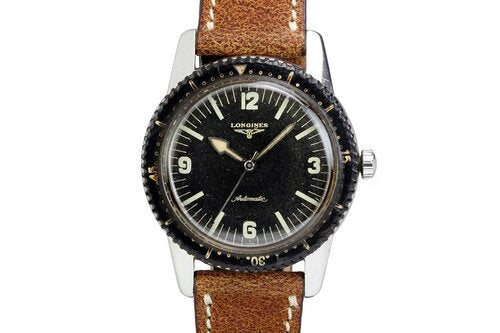
(Longines Skin Diver model number 6921)
The case is manufactured by Ervin Piquerez, SA (EPSA), and the part that seals the case uses EPSA's famous patented technology called "Compressor", which makes it highly water resistant.
As the water depth increases, the water pressure on the back cover increases, forcing the back cover to press more firmly against the O-ring gasket, thereby increasing water resistance.
EPSA often produces dual crown, inner bezel cases, but they also make single crown cases, such as those used in the Nautilus Skin Diver.
The Skin Diver's single crown also features the cross-hatching mark (a grid pattern) that is common to EPSA cases that use compressor technology.
Thanks to this compressor case, the Longines model 6921 is water resistant to a depth of 150 meters.
Models with external bezels used a fragile resin called Bakelite for the bezel, and many of the remaining watches today are often cracked or scratched.
For these reasons, watches with aluminum bezels instead of Bakelite and with large engraved numerals began to be made.
The most interesting part about the Nautilus Skin Diver is the case back, which features an engraved image of a diver holding a harpoon.
Longines model 6921 was only produced for a few years at the end of the 1950s, and it is estimated that only about 550 pieces were made across its three sub-numbers, 6921-1, 6921-2, and 6921-3. (Compared to Patek Philippe model 1518, which was produced in 281 pieces, this gives an idea of how few pieces there are.)
The three sub-numbers differ only due to different production lots.
All three models have the same dial, with the Longines logo at the 12 o'clock position and the word "Automatic" at the 6 o'clock position.
If you see a dial with the word "Automatic" written just below the Longines logo, it is a reproduction.
The hour hand is wide and coated with luminescent paint, and the thin minute hand is also coated with luminescent paint, making it easy to read the time.

(Longines Skin Diver model number 6921 traded at Phillips in 2017)
Perhaps because the 6921 was not a successful competitor to other diver's watches, Longines quickly shifted its resources to another diver's watch, the 7042.
Either way, all of this has made it an extremely rare and collectible piece in the modern world of vintage watches.
This is why Nautilus Skin Divers fetch such high prices when put up for auction.
In 2019, model 6921-3 was sold at auction on Tooveys for approximately 2.9 million yen, including a premium from the winning bidder, despite the fact that it was missing a bezel (and the crown had also been replaced, making its authenticity uncertain).
Other examples of transactions include:
- A model 6921 with a service parts bezel was sold at Phillips and sold for over 2.6 million yen.
At Watches of Knightsbridge, a watch with what appeared to be a reproduction dial sold for over 650,000 yen in 2015.
In 2017, a collector purchased a watch with the original bezel (which had since been repainted) at Omega Forums for 1 million yen.
- Sold by a sales company called Matt Bain for an undisclosed amount.
- Sold by a sales company called @anticdaro for an undisclosed amount.
As these high-value transactions show, it is difficult to find a model 6921 with all of its original parts, even if you search the far corners of the world.
The Skin Diver is a truly rare vintage watch that deserves to be highly prized among those in the know.
Longines Super Compressor 7042
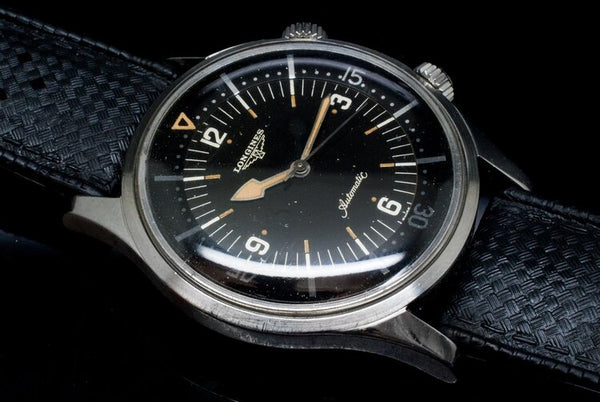
(Longines compressor model number 7042)
If the Nautilus Skin Diver is the forgotten stepchild of Longines' dive watch family, the Super Compressor, reference number 7042, is an undisputed icon.
Like the Nautilus Skin Diver, the Super Compressor uses an EPSA case, but this one has EPSA's famous inner bezel and dual crown case.
At the time, many brands were using Super Compressor cases, but Longines was part of the "holy trinity" of manufacturers that used Super Compressor cases, along with Jaeger-LeCoultre and Universal Genève.
(No disrespect to IWC, Benrus, Bulova, Enica, Hamilton and many other brands that use Super Compressor cases, which are also very nice.)
The Longines Super Compressor case is 42mm in diameter, is water resistant to a depth of 100 metres, and is powered by the same 19AS automatic calibre as the Skin Diver.
Like the Skin Diver, the EPSA has two crowns with its distinctive checkered pattern, the crown at 2 o'clock being used to rotate the inner bezel.
This Super Compressor dive watch has a slightly cleaner, smoother look compared to watches with an outer bezel.
To be honest, what attracted me to the EPSA Super Compressor case watches was the ease with which they were available in 36mm in addition to the standard 42mm models, but I think the clean look had a bigger impact as well.
Model 7042 has a glossy black dial with an eye-catching arrangement of the numbers 3, 6, and 9. When you turn the crown at the 2 o'clock position, a simple inner bezel rotates.
Among the model 7042s, the early "Mark 1" bezel models have four dots for each minute around the number 15, while later models only have three.

( The four dots around the 15 indicate that it is a "Mk1" bezel. )
Also, some of the early dials are very unusual in that the 3-6-9-12 o'clock markings are tiny radium-based dots rather than the luminous lines common to later models.
Another distinctive feature of the early dials is that the hour markers are small, thin, and luminous, making them look more refined than the later model dials, which have thick markers that are heavily coated with luminous paint, making them look more like a tool for measuring time.
According to Longinesoassion, these rare early dials are reference numbers 7042-1 and 7042-2, and are characterized by the use of radium luminescent paint and the word "Swiss" only at the 6 o'clock position.
Later production 7042s were fitted with tritium luminescent paint, reflecting the fact that Longines changed the luminescent paint company-wide from radium to tritium midway through the production run of the 7042.
I have found both early and later models with the Mk1 bezel, so I don't think the Mk1 bezel is an indicator of whether something is an early or late model.

(Longines model 7042 with Mk1 bezel and early dial)
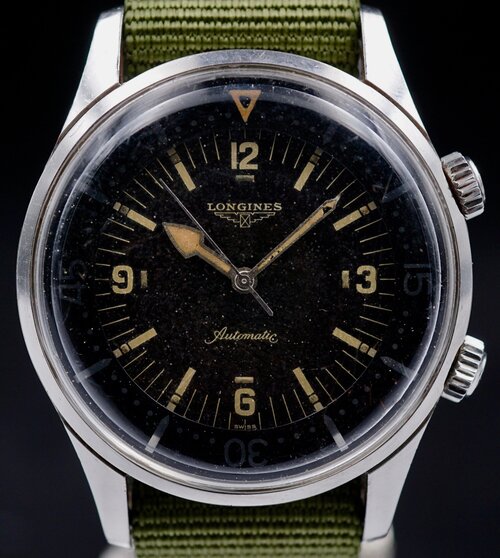
(Longines model number 7042, which has a later dial design)
Based on serial numbers and receipts (for example, there are serial numbers 10xx), it is clear that the Longines Super Compressor was released as early as 1958, and it is highly likely that it was a model produced at the same time as the Nautilus Skin Diver.
Like the Skin Diver, the original Super Compressor was only in production for a few years before being phased out by Longines to make way for the reference 7150, which was updated to match Longines' improved automatic calibre 290.
Although there are some changes between the Model 7150 and the original Super Compressor, it retains the beauty of the original model to an amazing extent.
There are variations depending on the sub-number of model number 7150, so I will research the successor model to 7150 on another occasion.
Unlike the Nautilus Skindiver, which is almost never seen on the market, compressor model 7042 is relatively easy to find for sale.
However, that doesn't mean that original models in good condition are easy to find.
Again, production lasted only a few years from the late 1950s to the early 1960s, and they were made using specialized tooling, so there are probably very few left in a condition that would make you want to purchase one.

(Longines model number 7042 with Mk1 bezel and later dial)
Heritage Collection: The Relaunch of the Diving Watch
In recent years, vintage-inspired "heritage" collections have become popular with various brands, and Longines was the pioneer in this trend, releasing reissues.
Inspired by the compressor reference number 7042, Longines launched the Legend Diver in 2007 and the range has continued to expand.
Nowadays, watches are available in a wide variety of dial colors, sizes, and materials.
Longines also released the Heritage Skin Diver in 2018, which is based on the model 6921.
Although I personally prefer the Legend Diver, I think it would be worth paying homage to the lesser known vintage models by releasing a modern version called the Heritage Skin Diver.
This article is merely an introduction to Longines' early diving watches.
Further research is needed to classify diver's watches and determine what their original, authentic prototypes were.






